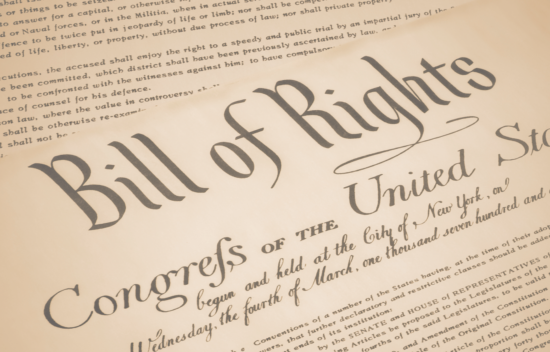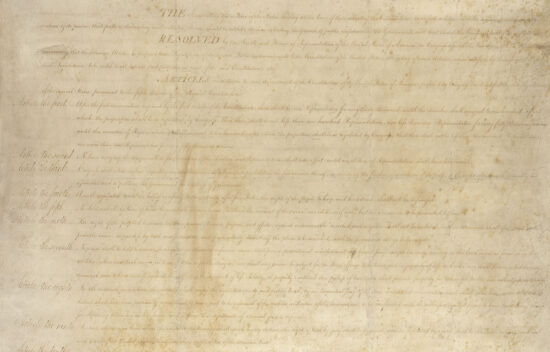
The Bill of Rights
50 minHow does the Bill of Rights protect freedom?
Students will:
- Identify fundamental liberties protected by the Bill of Rights.
- Analyze the connections and interdependence among the protections in the Bill of Rights.
- Evaluate situations in which rights may be violated.
- Appreciate the Bill of Rights and its protection of liberty.
- The Bill of Rights [Appendix C]
- Handout A: The Value of Rights
- Handout B: Bill of Rights Scenario Cards
- Handout C: The Bill of Rights Today [optional]
- Handout D: Life Without Rights for the Accused [optional]
- Ask students to share and explain some of their responses to Handout A. Then engage the class in a large group discussion to answer the questions:
- What similarities do you find among the rights people generally ranked as most important?
- Do you think responses might change based on the following factors: Age—would the rights have a similar ranking if the students were adults? Place in history—would the rights have a similar ranking if the students lived during the Founding era? The Civil War? The Progressive Era? Family—would the rights have a similar ranking if the students’ parents were lawyers? Ministers? Convicted felons? Members of the military?
- Why is it wrong for governments to infringe on these individual rights?
- Conclude the discussion by reminding students that many of the rights in the Bill of Rights are natural human rights all people are born with, and that nobody should have to live without. The Bill of Rights was written to protect individuals from government infringing on those rights.
- Divide the class into twelve groups. Give each group one Card from Handout B: Bill of Rights Scenario Cards. Referencing their copies of the Bill of Rights, groups should write their answers to the following questions: 1) Which right (if any) is being violated? and 2) Which amendment (if any) offers protection against such a violation?
- After two or three minutes, have groups pass their Scenario Card another group. Continue until each group has responded to every Scenario Card.
- Ask one member of each group to line up in the front of the room in order of amendments to create a “living Bill of Rights.” (Some amendments will have more than one representative in line.)
- Have each representative read their group’s Scenario Card and share their group’s response. See the Answer Key for correct answers.
- When going over Scenario Cards which focus on Supreme Court cases, ask students to evaluate the Court’s ruling. Did the Court decide the constitutional question correctly?
Ask students if the protections for individual rights that were added to the Constitution in 1791 are out of date, or if they are still important today. What current issues highlight the importance of Bill of Rights protections?
- Distribute Handout C: The Bill of Rights Today. Have students research current events that illustrate the rights and protections guaranteed in the Bill of Rights. Students can begin their research by reading “Bill of Rights in the News” stories updated daily at: www.BillofRightsInstitute.org.
- Have students read the narrative on Handout D: “Life Without Rights for the Accused,” which tells a fictional story of an accused person living in a society where government does not honor the criminal procedure protections in the Bill of Rights. Have them identify the violations of rights. Then ask them to write their own “Life Without…” story. For example: “Life Without Freedom of Expression,” (which would include speech, press, assembly and petition); “Life Without Freedom of Religion,” or “Life Without Protection for Private Property.” Student may then:
- Trade papers and challenge a friend to find the violations in their story
- Give the class buzzers or flags; have one student read his or her story aloud while the rest of the class buzzes or raises a flag when a violation has occurred.
- Combine stories into one long series of narratives which they can share with other classes.
Assign students to work in pairs to research one of the topics (e.g. criminal procedure, religion, expression, etc.) from the Bill of Rights in the News Activities section of the Bill of Rights Institute Web site. Have them present a five-minute summary of major positions on the issue, and conclude with their opinions. Activities can be found at: www.BillofRightsInstitute.org





